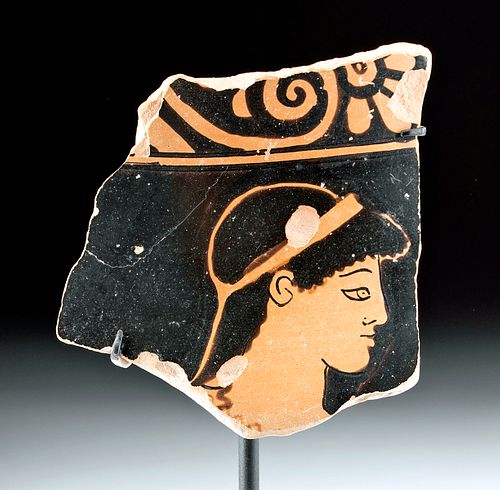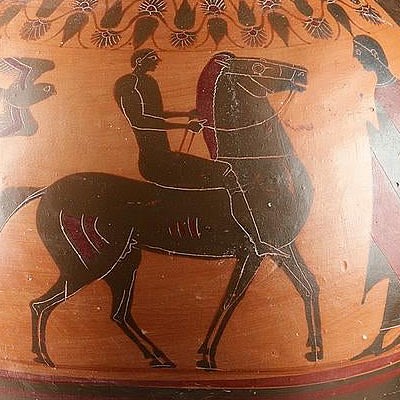Attic Red-Figure Fragment Syleus Painter, ex-Christie's
Lot 22e
About Seller
Artemis Fine Arts
686 S Taylor Ave, Ste 106
Louisville, CO 80027
United States
Selling antiquities, ancient and ethnographic art online since 1993, Artemis Gallery specializes in Classical Antiquities (Egyptian, Greek, Roman, Near Eastern), Asian, Pre-Columbian, African / Tribal / Oceanographic art. Our extensive inventory includes pottery, stone, metal, wood, glass and textil...Read more
Estimate:
$3,000 - $6,000
Absentee vs Live bid
Two ways to bid:
- Leave a max absentee bid and the platform will bid on your behalf up to your maximum bid during the live auction.
- Bid live during the auction and your bids will be submitted real-time to the auctioneer.
Bid Increments
| Price | Bid Increment |
|---|---|
| $0 | $25 |
| $300 | $50 |
| $1,000 | $100 |
| $2,000 | $250 |
| $5,000 | $500 |
| $10,000 | $1,000 |
| $20,000 | $2,500 |
| $50,000 | $5,000 |
| $100,000 | $10,000 |
| $200,000 | $20,000 |
About Auction
By Artemis Fine Arts
Jun 4, 2020
Set Reminder
2020-06-04 10:00:00
2020-06-04 10:00:00
America/New_York
Bidsquare
Bidsquare : Exceptional Antiquities, Asian, Ethnographic
https://www.bidsquare.com/auctions/artemis-gallery/exceptional-antiquities-asian-ethnographic-5185
An important one-day auction featuring museum-worthy examples of Egyptian, Greek, Roman, Etruscan, Near Eastern, Far East / Asian, Pre-Columbian, African / Tribal, Oceanic, Native American, Spanish Colonial, Russian, Fossils, Ancient Jewelry, Fine Art, so much more! Artemis Fine Arts info@artemisgallery.com
An important one-day auction featuring museum-worthy examples of Egyptian, Greek, Roman, Etruscan, Near Eastern, Far East / Asian, Pre-Columbian, African / Tribal, Oceanic, Native American, Spanish Colonial, Russian, Fossils, Ancient Jewelry, Fine Art, so much more! Artemis Fine Arts info@artemisgallery.com
- Lot Description
Ancient Greece, Athens (Attic), attributed to the Syleus Painter, ca. 480 to 470 BCE. A fragment from an Attic red-figure pelike depicting a profiled head donning a diadem with a register of floral motifs above. This piece has been attributed to the Syleus Painter. For more about the Syleus Painter, see the biographical statement from the J. Paul Getty Museum in the extended description below. Size: 2.2" W x 2.45" H (5.6 cm x 6.2 cm); 4.25" H (10.8 cm) on included custom stand.
According to the J. Paul Getty Museum, "The Syleus Painter was a vase-painter who decorated pottery using the red-figure technique in Athens during the early 400s B.C. As with most vase-painters, his real name is unknown and he is identified only by the stylistic traits of his work. He is called the Syleus Painter because one of his vases, now in Copenhagen, shows the Greek hero Herakles fighting the villain Syleus. The Syleus Painter most often decorated large vases with mythological scenes.
The Syleus Painter demonstrates some of the problems of identifying Greek artists by their stylistic traits alone. At the beginning of this century, the great scholar of Greek vases Sir John Beazley put together a number of stylistically related vases that he called the Syleus Sequence. Within this large group, he further distinguished four smaller stylistic groups. He attributed these four smaller groups to four different artists called the Painter of the Munich Amphora, the Gallatin Painter, the Diogenes Painter, and the Syleus Painter. Scholars now question whether these four stylistic groups each should represent the work of an individual artist or if the groups are better understood as four stages in one artist's career."
See a similar fragment at the Getty Museum (object number 77.AE.21).
Provenance: private Connecticut, USA collection; ex private collection, Germany (1912-1993); ex A.S. Richter collection, California, USA, acquired 21 November 1996; ex Christie's London 3 July 1996 - part of lot 71
All items legal to buy/sell under U.S. Statute covering cultural patrimony Code 2600, CHAPTER 14, and are guaranteed to be as described or your money back.
A Certificate of Authenticity will accompany all winning bids.
We ship worldwide and handle all shipping in-house for your convenience.
#155932A lovely fragment with light wear to pigment as shown, including a few small pits on the surface. Motif is well preserved.Condition
- Shipping Info
-
All shipping is handled in-house for your convenience. Your invoice from Artemis Gallery will include shipping calculation instructions. If in doubt, please inquire BEFORE bidding for estimated shipping costs for individual items.
-
- Buyer's Premium



 EUR
EUR CAD
CAD AUD
AUD GBP
GBP MXN
MXN HKD
HKD CNY
CNY MYR
MYR SEK
SEK SGD
SGD CHF
CHF THB
THB












